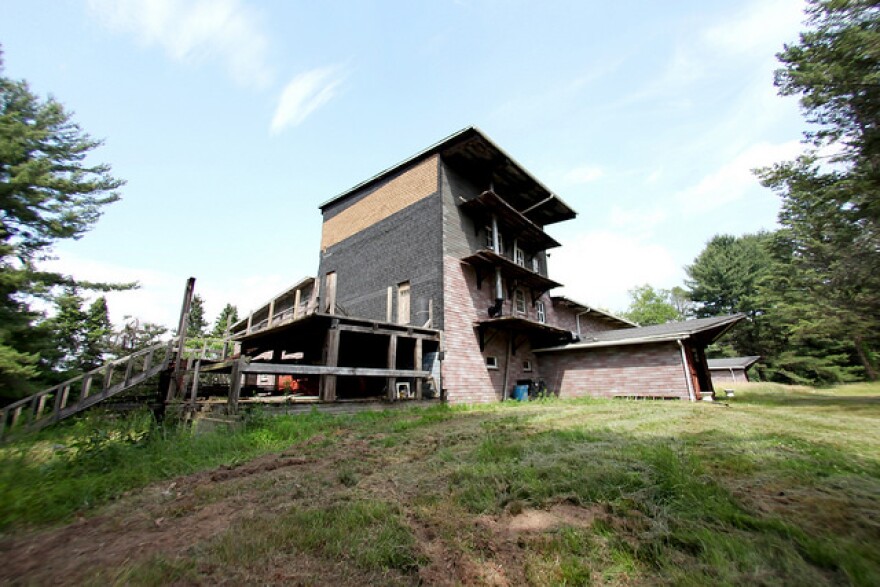You might say that the two great loves of Edwin Thrall’s life were his wife, Flicka, and his daughter, Janett -- his only child, who he wanted to protect -- so he built his third great love, a square dance hall, a place where his wife could dance, and his daughter could be safe.
In a 1997 documentary, Ed Thrall said that he wanted a place to call square dancing. "I wanted a place for Janett to have her friends, and give them recreation that we thought was civilized, and moral, and helpful, and would last them as long as they lived."

Thrall died in 2003, at the age of 84. His daughter Janett Moore said he was very generous and a true Yankee, but also had a strong stubborn streak. Not long before his death, he spent six months in prison for getting into a shootout with local police -- and it wasn’t the first time that happened.
Thrall would say he didn't intend to hurt anyone, but to protect what he considered his: the 20,000-square-foot dance hall that he spent ten years meticulously constructing.
"He had a very strong sense that his property was his, and to do with what he wanted," Moore said. "When he first got the permit, there was no zoning. Then zoning was put into place, and he didn't like it. The town and he started to butt heads, and it got very ugly."


Today, the property is only slightly different than it was when Thrall was alive. At the end of a long winding driveway, across from the family’s old potato farm, the building is an L-shaped structure covered in black, brown, and purple shingles. It's a long hall, with a four-story tower on one side. It looks unfinished, with scaffolding.
Moore said her father built it mostly by himself, between 1968 and 1978. She and her husband, Doug Moore, gave a tour to WNPR producers, along with Howard Epstein, professor of engineering at UConn. Epstein has been involved with the building for years, facilitating student projects, and advising the Moores.

You could say Ed Thrall was in the right place at the right time. Old buildings in Hartford and surrounding towns at the time were being dismantled to make room for highways. Thrall helped demolish many of these buildings, and collected what was considered “junk.”
"Probably, if you sold this thing for parts, it would be worth millions," said Epstein. "Sometimes in lieu of being paid, he’d say, 'Can I have that?' He was called the old stone picker."
"He got into Hartford, and saw everything being demolished," Janett Moore said. "He has this farm; started bringing everything home. At some point, he said, 'What am I going to do with all this?' and that's when he decided to build this, and he just started building."


Thrall collected a counter from Spinella’s Spaghetti Factory; a spiral staircase from the foyer of Landers, Frary & Clark; floor trusses from the Billings and Spencer Building; and brownstone, granite, and a railing from theHeublein Hotel. He even recovered a speakeasy door from Hartford's Garde Hotel, covered in messages written with lipstick.
Thrall’s wife designed the tiled floors with different patterns of colors, to correspond with more than 200 dancer positions. The dance hall itself is 70 feet wide, lined with benches.
The floor is not attached to the wall, but is supported by enormous truck tires. "Tires connected by hoses, so the pressure can be adjusted, depending on how much bounce you want," explained Epstein.
Janett Moore and her husband got married at the hall 30 years ago, one of a few private weddings and events they’ve had on the property. They aren’t allowed to rent it out now because it isn’t up to code, a problem that her dad dealt with throughout his life.
At one point, the town put an injunction on the property, to keep Ed Thrall from hosting events, which they thought were too dangerous. He, of course, didn’t listen, and ended up in prison for 50 days.

Thrall held a few events, some where the police actually showed up to dance. But he couldn’t shake the bad relations between him and the town.
It wasn't only the police shoot-outs that led to a rift in his own family. The dark stain on Ed Thrall’s legacy came when he invited the Klu Klux Klan to town, to have a rally on his property.
Janett and Doug Moore said that the KKK misrepresented themselves, posing as a property rights group, and that the group took advantage of Thrall's anger towards the town and used it for their own publicity.
In interviews, Thrall said the organization was “strictly business people” and not racist, despite the fact they held a cross burning on his yard. Whatever the case, it cost him a lot of credibility in the community. "Every time this story is told, that’s obviously the big flash that shows up," Doug Moore said. "Here’s where it happened. It’s been misrepresented."

"What we’d love to do is make an event facility," said Janett Moore. "We’d love to get through the zoning and all that, have it be a legal structure. It really is a place people should come and enjoy." The Moores and Epstein plan to keep working at it, until Edwin Thrall’s Hall is open to the public.
Listen to the whole story below, and take a look at more photos from Thrall Hall.















